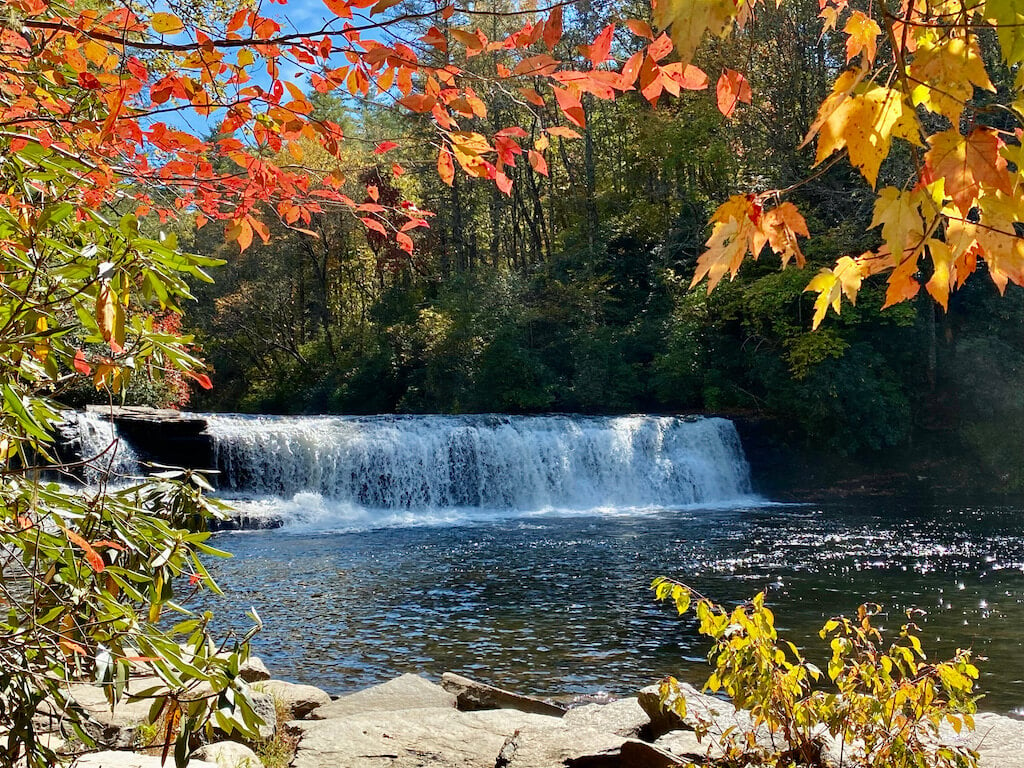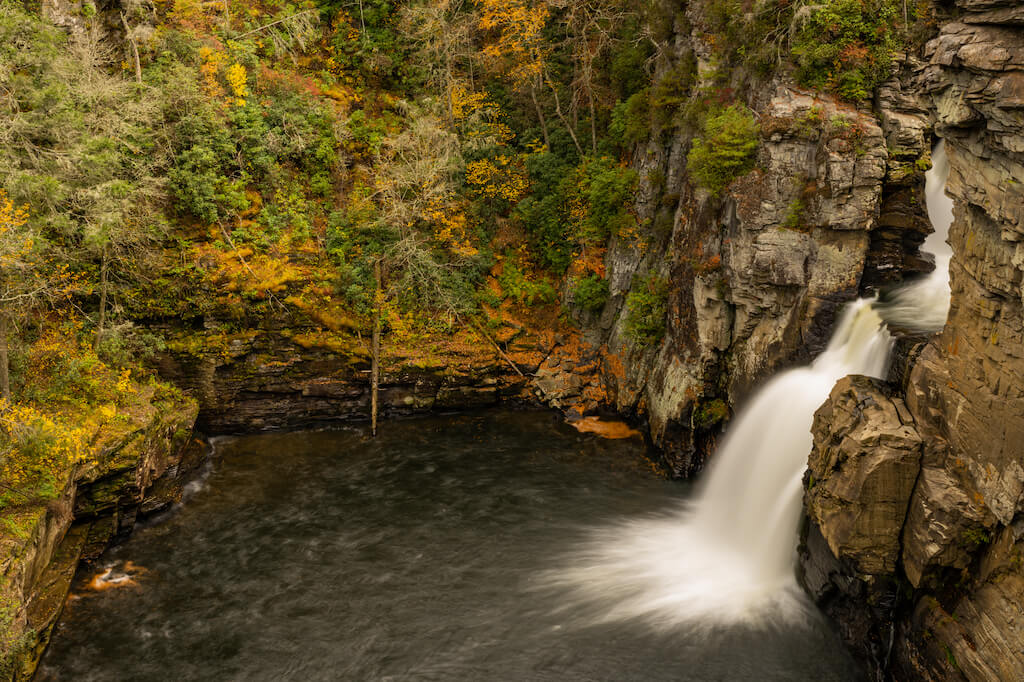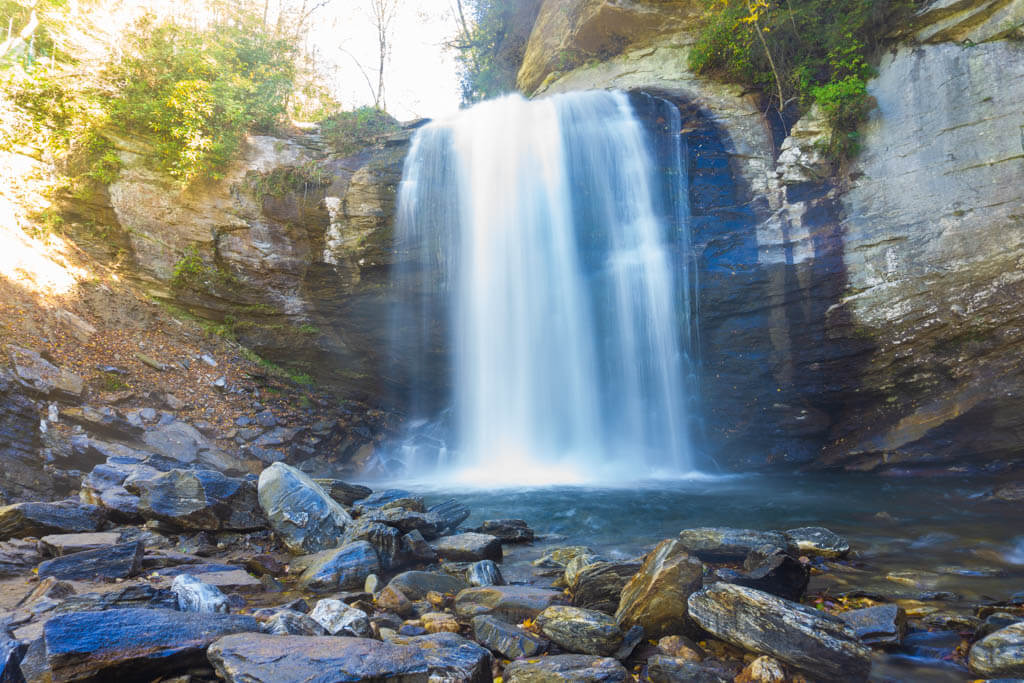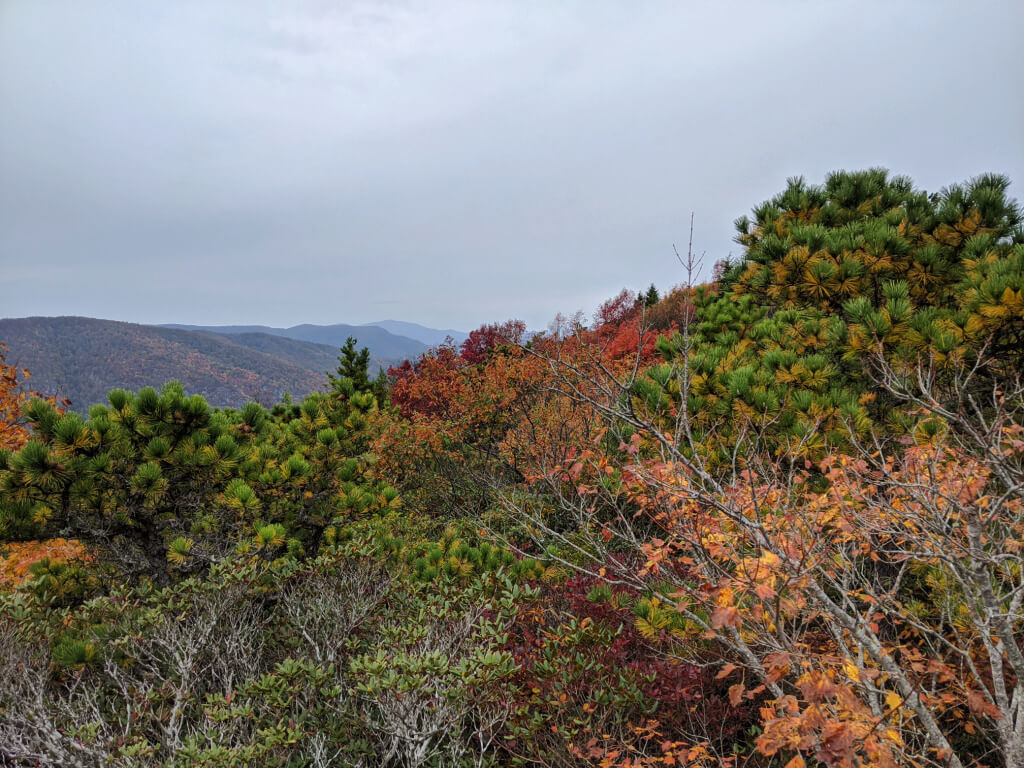Between late September and through much of November, fall in North Carolina is a spectacle of brilliant red, gold, and orange leaves. It’s one of the best places to enjoy autumn in the USA.
You’ll find the most breathtaking leaf peeping in the western part of the state wrapping a swath of electric color around one of America’s most scenic drives: the gorgeous Blue Ridge Parkway.
When does fall start in North Carolina? Fall color settles first like a whisper at higher elevations in the mountains, painting the treetops near Grandfather Mountain and the famous Linn Cove Viaduct as well as at high points in Pisgah National Park.
But as nights become cooler, fall colors begin to deepen and flow down to lower elevations around Asheville. (A weekend in Asheville is lovely.)
Because of the variety of elevations, Western North Carolina puts on one of the longest shows of fall color anywhere in the USA.

North Carolina in Fall
North Carolina in the fall is a real treat and a little planning can help you get the most of your visit. Keep an eye on the fall colors forecast and report as you plan your trip and be sure to choose a base near the areas you want to see.
The Blue Ridge Parkway is 469 miles long so plan on a very long day if you’ll be staying in Asheville and heading to Grandfather Mountain and back. Earlier in the season, consider basing in places like Boone or Blowing Rock.
Hendersonville or Asheville make good choices later in the season as the color comes to middle and lower elevations. (See “where to stay” below.)
Here are the very best places to see!

1. DuPont State Park
DuPont State Park—also known as DuPont Forest—makes the perfect destination for chasing waterfalls framed by colorful fall leaves.
With an elevation of 2,257 to 3,612 feet above sea level, colors arrive here just after they’ve peaked in the mountains. Choose from 27 moderate trails to take in the beauty.
If it’s waterfalls you’re after, consider an easy loop by parking at the Visitor’s Center and walking to High Falls overlook.
If you take the path to the right, you’ll arrive at the bottom of High Falls.
Then walk back to the main trail and down the stairs to Triple falls, walking further down the river to Hooker Falls.
Parking tip: There are several parking lots throughout DuPont State Park, but unless you arrive very early, you’re going to be competing with other leaf peepers for limited spots.
If you’re willing to be patient and loop around the lot a few times though, you’re likely to get a spot eventually.
Nearby Hendersonville is a charming mountain town with a great restaurant scene. It makes the perfect base for visiting this area but Asheville is just an hour’s drive away, too.
We stayed in an idyllic restored 1940’s cabin on the parkway that we’d highly recommend. It’s one of my favorite stays! You can check price and availability on the cabin near Hendersonville here.

2. Linn Cove Viaduct
Arguably one of the world’s finest road trips, the Blue Ridge Parkway was conceived by President Franklin D. Roosevelt as a means to improve American infrastructure and provide jobs in the wake of the Great Depression.
Designed to connect Great Smoky Mountains National Park in North Carolina to Shenandoah National Park in Virginia, the 469-mile road began construction in 1935, and all but the last 7 miles was completed in 1966.
So why did the 7-mile section around the Grandfather Mountain take an additional 21 years?
Well, once you drive across the marvel of engineering known as the Linn Cove Viaduct, it immediately becomes obvious.
The Viaduct is a 1,243-foot-long, concrete bridge that snakes around the massive mountain, with 153 segments weighing 50 tons each.
It’s one of the most iconic, most popular, and most photographed attractions along the entire Parkway (which is, itself, the #1 attraction in the U.S. National Park System, with some 15 million annual visitors).
You’ll find some of the best Blue Ridge Parkway hikes here, taking trekkers up the side of a mountain that offers numerous spectacular viewpoints along the way.
Bret |Blue Ridge Mountains Travel Guide

Where to Stay for the Best Leaf-Peeping
Early in the season: Stay near Boone or Blowing Rock.
This hand-hued log one bedroom log cabin sleeps six and offers epic Blue Ridge mountain views from the hot tub on the deck! Check price and availability here.
Later in the season: Stay in Asheville or Henderson.
We loved our stay in a cozy, renovated 1940’s cabin in the mountains 5 minutes from the cute little town of Henderson. Check price and availability here.
3. Grandfather Mountain
One of the most popular stops—just up the road from the Lin Cove Viaduct on the Blue Ridge Parkway at Mile Marker 302.8—is the Rough Ridge Lookout. You’ll enjoy views from the viaduct as well from here.
It’s an easy hike too…just 1/3 mile uphill from the parking lot along a boardwalk. Keep walking and you’ll come to a stunning viewpoint you can enjoy from some huge boulders there. The Rough Ridge summit is 4,773 feet high!
With more time, consider heading to nearby Grandfather Mountain State Park, an unmatched ecological sanctuary with 2,456 acres of truly spectacular terrain for hiking.
The highlight here is a mile high long swinging bridge; it’s a 228 foot suspension bridge over an 80 foot chasm with 360 degree panoramic views.
The only downside is the steep entrance fee to the park. When we visited in fall 2021, it was $22 per person.
However, your admission comes with a narrated audio tour as you drive the park as well as detailed maps and history of the park.
It’s an absolutely gorgeous place to experience autumn in North Carolina and remember, your fee goes to a good cause…protecting this treasure for future generations.

4. Linville Falls
Linville Falls is a beautiful place to visit year-round but when the fall colors begin to pop, it is truly eye-popping. It’s by far one of the best locations to visit for the fall season in North Carolina!
For the best view of the waterfalls and the fall color surrounding them, take the Erwins View Trail which is a 1.6-mile out-and-back trail from the Linville Falls Visitor Center and has an elevation gain of 246 ft.
Chimney View is just below Erwins View on the trail and you’ll have a closer look at the upper and lower falls.
Erwins View Trail is considered moderate so if you need something a little easier, just hike to the upper falls which is only a mile out-and-back with an elevation gain of 82 ft.
There is a large paved parking lot at the Visitor Center or you can park in a USFS gravel lot off of Old NC 105.
If you park there, make sure you continue on down the road after hiking at the falls and go to Wiseman’s View Trail.
This short trail is paved for part of the way and leads to one of the most beautiful views of Linville Gorge. The overlook offers panoramic views directly across from Hawksbill and Table Rock Mountains.
Be warned though: High-clearance vehicles like a truck or SUV are recommended. This is a gravel road and can be very washed out!
Anna | Stuck On the Go

Read more on U.S. fall travel:
• Where to see Colorado’s fall foliage
• 21 places to see in November in the USA
• California in October
• Where to see fall colors in California
5. Price Lake
Another one of the most popular Blue Ridge Parkway attractions in the North Carolina High Country, Julian Price Memorial Park is located at Milepost 296.7, just south of the towns of Blowing Rock and Boone.
The land was formerly owned by insurance executive Julian Price (founder of the Jefferson Standard Life Insurance Company), who purchased the 4,200-acre property as a relaxing mountain getaway for his employees.
But once he passed away in 1946, the land was donated to the U.S. National Park Service.
Today, the park named in his honor features a peaceful picnic area, lakeside campgrounds, fishing pond, and plenty of the area’s best hiking trails (including the superbly scenic 5-mile loop of the Boone Fork Trail).
But its show-stopping centerpiece is Price Lake, which is widely considered to be among the most beautiful lakes in North Carolina.
The picturesque lake is open to rowboats, canoes, kayaks, and paddleboards, all of which are available from local rental services.
Fishing is also permitted here, with either a valid North Carolina or Virginia fishing license.
While the lake is almost achingly lovely at all times of year, it is especially photogenic in the fall, when the brilliant reds, golds, and greens create mirror-like reflections in the tranquil waters.
With Grandfather Mountain, the Linn Cove Viaduct, the Blowing Rock, and Moses Cone Memorial Park all less than 10 miles away, this is arguably our favorite part of North Carolina’s Blue Ridge Mountains.
Mary |Blue Ridge Mountains Travel Guide

6. Forest Heritage National Scenic Byway
There are dozens of things to do along Forest Heritage National Scenic Byway, especially for fall foliage.
It may not offer as many views from lookout points as some scenic drives in North Carolina, but it offers equally magical sites, like waterfalls, rivers, and hikes.
The best place to start the 76-mile drive is Brevard, but it also goes through Canton and Rosman. (Consider staying a few days to attend Halloweenfest in town).
Many favorite spots are packed into the first 15 miles. Looking Glass Rock Hike off mile 5.2 is a 6.5 miles out and back trail (gaining 1730 feet in three miles) through tons of fall foliage that ends with sweeping mountain views.
Just a half mile later, Looking Glass Falls at mile 5.6 is a 60-ft roadside waterfall.
For some quieter stops, the Cradle of Forestry in America at mile 11 has three easy one-mile, no elevation trails for a small fee. (Plus, you also get access to a discovery center and education).
Towards the end of the drive, you can stop at Dill Falls, two miles off the Byway on Forest Service Road 4663.
It’s a 50-ft waterfall separated into Upper and Lower Falls, but neither trail is difficult or strenuous (about a mile for both, total).
MacKenzie | Rainbow Travel Life

7. Pisgah Inn
Pisgah National Forest is a convenient 40 minute drive from Asheville and has some great leaf peeping on the earlier side of the season if you know where to go.
Head directly to Pisgah Inn, a historic inn since 1919. The inn bills itself as “peak of the parkway” with good reason.
It’s at the top of Mount Pisgah at a 5,000 foot elevation, making it a great place to see fall color early in the season.
You can either make a reservation for dining on its terrace with epic views of the Blue Ridge Mountains or, if you’re on a budget, feel free to pack your own picnic.
Just grab one of the many outdoor Adirondack chairs with mountain views and relax into serenity.
There’s nice gift shop here, too, with handmade Appalachian crafts, jewelry, and more.
It’s also a popular place to stay due to the stellar Blue Ridge Mountain views from most of the rooms.
Check price and availability at the Pisgah Inn here.

8. The Biltmore Estate’s Walled Gardens
What? Fall leaf peeping at the Biltmore Estate? Not exactly…but if you’re in the Asheville area in fall, you’ve got to see the Walled Gardens.
In fall, they’re planted with hundreds of vibrant orange Mums and purple Salvia!
To experience the grandeur of European castles in the heart of America, Biltmore is the place to go.
With an expansive manor house boasting over 200 rooms, including an indoor garden room, a massive banquet hall, an envy-inducing library, a basement pool and bowling lanes, the house is truly a feast for the senses.
But the grounds, oh the grounds! Behind the manor are views of tree-covered Blue Ridge Mountains.
There are also trails to walk and multiple themed gardens to stroll through. Head to the walled garden, the rose garden, the azalea garden, the conservatory.
In addition to symmetrical paths and carefully curated flower beds, features like arches, latticework, walls, and pergolas add to the visual appeal of the gardens.
These gardens are gorgeous anytime, but in fall, when the leaves are changing, the array of colors is absolutely breathtaking!
Be aware that the cost to visit Biltmore is steep: tickets start in the $60’s for adults, but the price is absolutely worth the experience.
Online reservations are required for timed entry into the house, but you can wander the grounds and gardens before and/or after your visit at your leisure.
Stephanie | The Unknown Enthusiast

9. Graveyard Fields
You’ll find Graveyard Fields at Milepost 418.8 on the Blue Ridge Parkway in Pisgah National Forest. It makes a great hike with lunch at Pisgah Inn.
As one of the earlier places to see fall color, it’s popular with hikers so get an early start to avoid crowds.
When we visited in fall 2021, it was still recovering from a massive storm that had washed out some trails, but hopefully will be fully recovered by next fall.
Hiking the full Graveyard Fields loop takes about 2.5 hours to cover 3.5 miles. There’s a small elevation gain of 450 feet.
You’ll head over a paved path initially and cross a bridge at Yellowstone Creek.
If you turn right after that, it’s just .2 miles to Lower Falls, which is spectacular in fall. (It’s a popular swimming hole in summer.)
If you head back to the main trail, you’ll enter a mountain meadow, meander down a boardwalk and back onto a trail and, if you turn left, you’ll find Upper Falls.
Return to the main trail and follow the loop back to the parking lot. This makes a great family hike!

10. Great Smoky Mountains National Park
Great Smoky Mountains National Park is the perfect leaf-peeping destination in North Carolina.
Autumn seems to last forever here. With an elevation span of over 5,000 feet, peak leaf season runs from mid-September to mid-November.
As one of the only parks in the national park system with free admission, it’s an accessible, affordable fall vacation.
The Smokies are a hiking destination first and foremost. The fall colors are best from Mt. Cammerer, Mt. Sterling, Mt. LeConte, Rocky Top, and Shuckstack Fire Tower…all moderate or difficult trails ranging from 8 to 18 miles.
Waterfalls in the Great Smoky Mountains also stand out when the seasons change. The short, easy hikes to three cascades near Deep Creek and Mingo Falls are local favorites.
Not a hiker? No problem! Enjoy the views from Clingmans Dome, the highest point in the park.
Or drive Route 441 and stop at the many overlooks along the way. You have a good chance of spotting elk in the early mornings on the road near Ocanluftee Visitors Center.
Crowds in the Smokies can be overwhelming in October. But you can get away from them easily by choosing longer (10+ mile) trails, or avoiding Cades Cove.
Don’t forget to pack your winter gear. Temperatures on the peaks often drop into the 20’s in October, and the wind is fierce on the ridge. Meanwhile, it can be 85 degrees and sunny at lower elevations.
Carrie | Trains Planes, and Tuk Tuks

11. Mount Mitchell
Mt. Mitchell State Park is an incredible place to visit during fall in North Carolina.
With bright, bold colors and sweeping mountain views, Mt. Mitchell is easily one of the best stops on a Blue Ridge Parkway road trip.
During your road trip to the summit, you will have the opportunity to see beautiful fall colors as you make your way up to the highest mountain peak east of the Mississippi River!
Mt. Mitchell is a part of the Black Mountain Range and has an elevation of 6,684 ft.
It is free to visit this state park and offers a handful of hiking trails, picnic areas, camping grounds, and an observation deck atop the mountain providing memorable panoramic views.
During the months of May to October, the restaurant, concession stand, and gift shop are open. When arriving, enjoy the short and slightly steep paved path to the summit’s observation deck.
After taking in the impressive views of Pisgah National Forest draped in fall colors below, consider strolling down the Balsam Nature loop (0.7 miles) which brings you through a scenic spruce- and fir-filled forest.
If you enjoy more challenging hikes, consider climbing the 6-mile (one way) Mt. Mitchell trail from Black Mountain Campground.
After exploring the grounds, enjoy a picnic or plan a BBQ at the picnic tables which offer stone grills, water, and 2 shelters.
Additionally, a trip to this Mountain Summit offers the opportunity to see a wide variety of birds—91 different species have been recorded)—as well as Black bears, White-tailed deer, and more!
Sam | Find Love & Travel

12. Hawksbill Mountain
Hawksbill Mountain is a popular sunrise and sunset viewing hike year-round but fall color is famous in this area.
The rocky summit has a few pops of red and yellow up top but the real draw is looking out over the rocky crags to the sea of orange, red, and yellow in the distance.
Looking out into the horizon, hikers can see Shortoff Mountain and Table Rock Mountain rising above the color.
At around 4,000 ft. elevation, Hawksbill’s fall peak tends to be in the middle of leaf peeping season and pairs well with the nearby Rough Ridge area or Linville Falls for a full day of foliage.
The trailhead is roughly 1.5 hours from downtown Asheville, but the drive is enjoyable by itself, taking place mainly along the colorful Blue Ridge Parkway.
The moderate trail is in the Linville Gorge Wilderness area, designed as an out-and-back that’s around 2 miles long.
You will see plenty of folks stopping to catch their breath; there is just under 700 feet in elevation gain all one-way without any real breaks in the steady climb.
The trail will take you to a relatively open rocky top with epic views at several different vantage points, with a few camping spots between the trees.
As a wilderness area, the trail is not marked, there are no bathrooms or trash cans so plan to pack out whatever you pack in.
While the trail is pretty straightforward, cell service will be limited or non-existent so download an offline map with Alltrails or Gaia to stay safe.
Located off a gravel forest service road, parking is very limited and visitors parking in non-designated areas risk being ticketed.
Pair these long range views with an easy Asheville hike and see all that western North Carolina has to offer.
Stephanie |Explore More Clean Less

See the Best of Fall in North Carolina
Ready for leaf peeping this fall?
Whether you head to higher elevations or soak in the season closer to Asheville, western North Carolina is absolutely majestic in fall.
Enjoy. Savor. Delight.

Leave a Reply